Affiliate disclosure: This post may contain affiliate links. Please see our Privacy Policy.
Himalayan Balsam (Impatiens glandulifera) is an edible and medicinal plant that loves shady wet spots. It’s like jewelweed’s much bigger cousin, and it grows to towering heights with large pink snapdragon-like flowers.
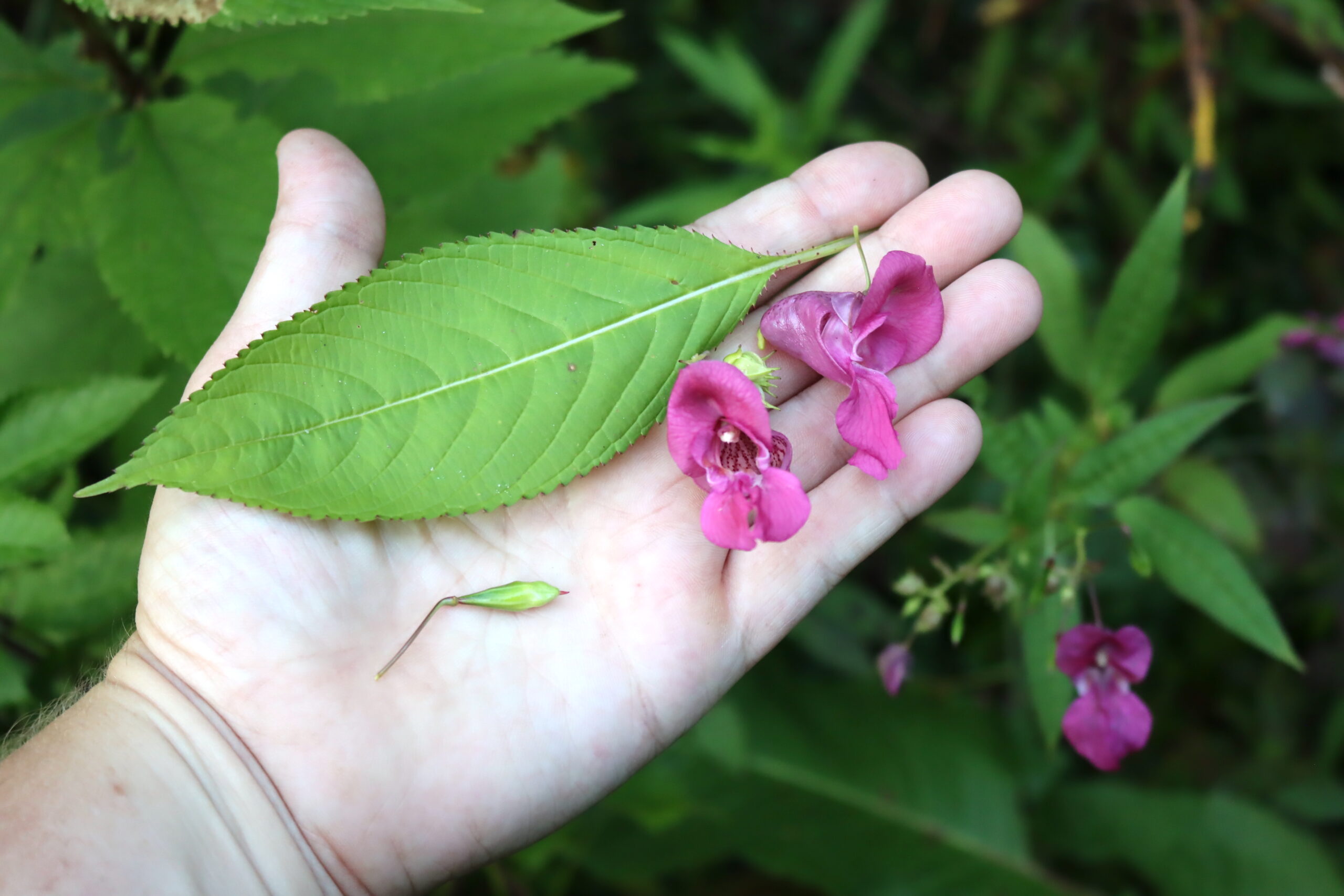
Himalayan Balsam is a wild species of impatiens that are hard to miss in the landscape. They grow huge, towering up to 10 feet tall (though 6 to 8 is more common), and produce a profusion of bright pink blossoms.
The flowers look a lot like another well-known impatiens species, namely orange flowered jewelweed. The plants are similar in many ways, with Himalayan Balsam being bigger and grander in all dimensions (and with pink flowers instead of orange, of course).
Both plants are both edible and medicinal and well worth seeking out.
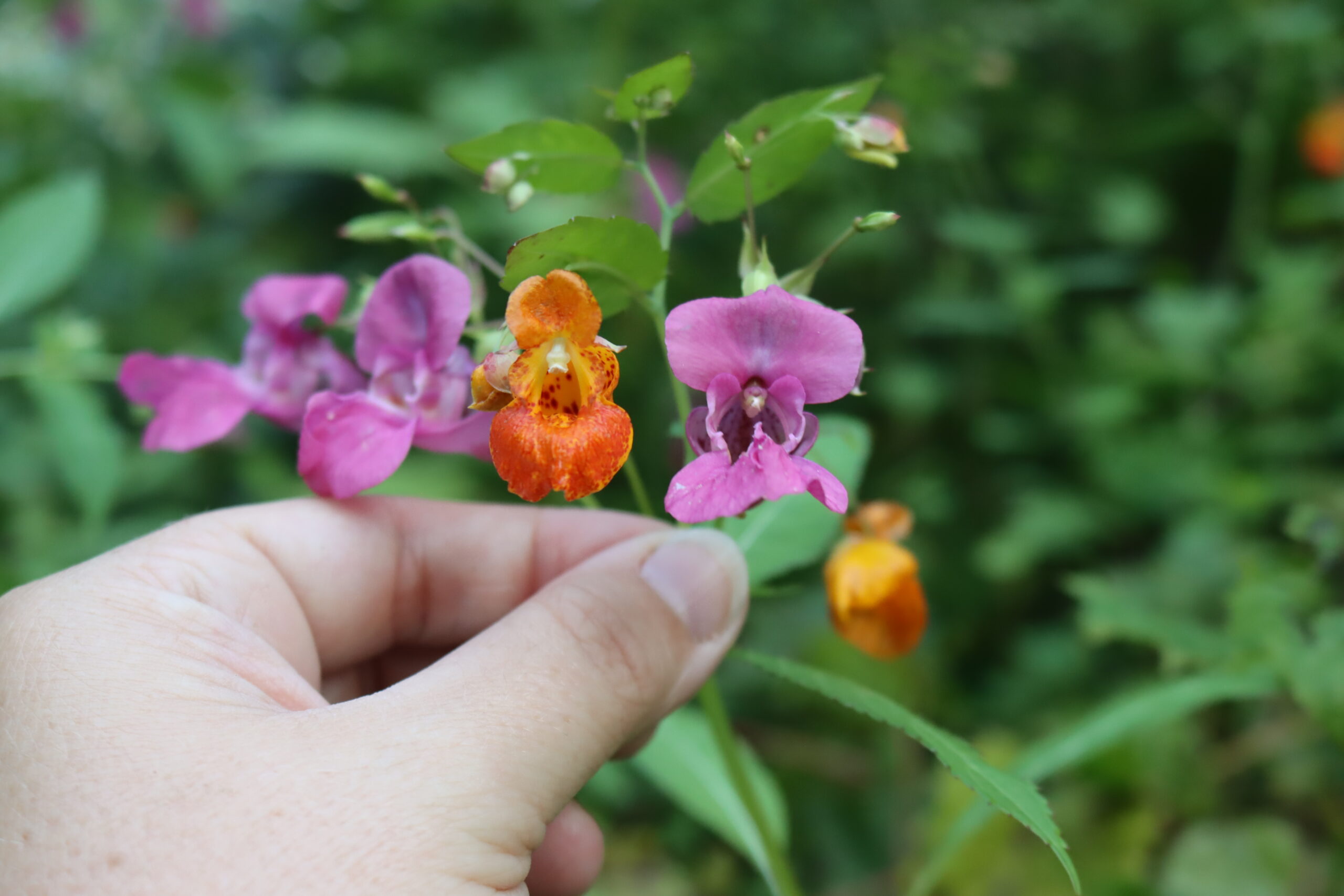
What is Himalayan Balsam?
Himalayan Balsam (Impatiens glandulifera) is a large, herbaceous, annual weed in the Balsam or Balsaminaceae family. You may also hear it called Ornamental Jewelweed, Kiss-Me-On-the-Mountain, Touch-Me-Not, Indian Jewelweed, Bobby Tops, or Policeman’s Helmet.
As its name suggests, Himalayan Balsam is native to the Himalayan regions of Pakistan, India, and Nepal. However, this plant can become aggressively invasive and has spread throughout much of North America, Europe, and New Zealand. It’s widespread in North America and is considered one of the United Kingdom’s most invasive species.
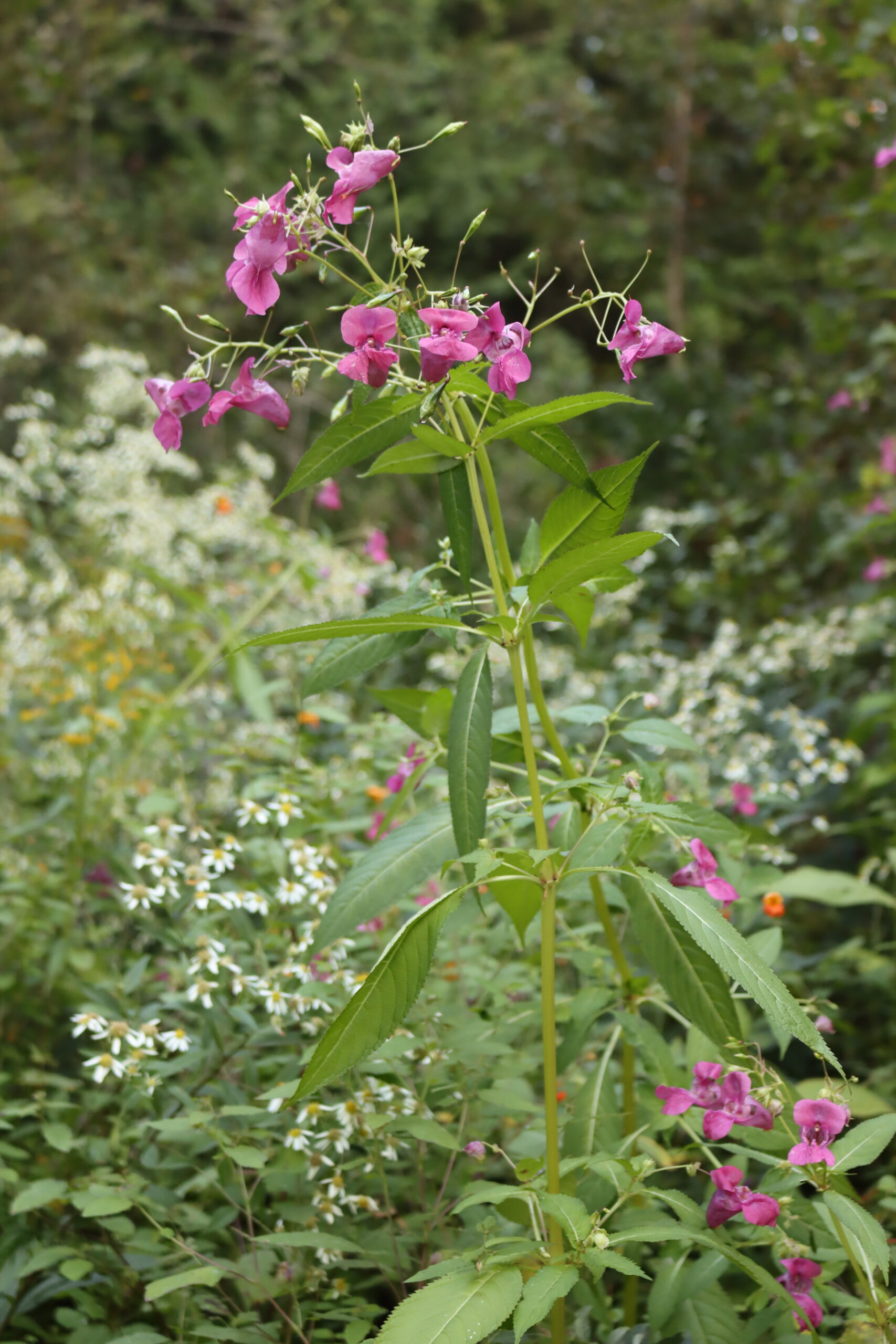
Is Himalayan Balsam Edible?
Himalayan Balsam is an edible treat for foragers. The leaves, young shoots, flowers, seed pods, and seeds are all edible. You can eat Himalayan Balsam raw or cooked. Herbalists also use Himalayan Balsam in internal and external preparations.
Himalayan Balsam contains calcium oxalate and high quantities of other minerals, so you should consume it in moderation, especially when raw. Avoid Himalayan Balsam if you are pregnant, nursing, or have gout, hyperacidity, arthritis, kidney or bladder issues. Calcium oxalate can contribute to kidney stones in people who are susceptible. Cooking Himalayan Balsam can reduce the calcium oxalate content.
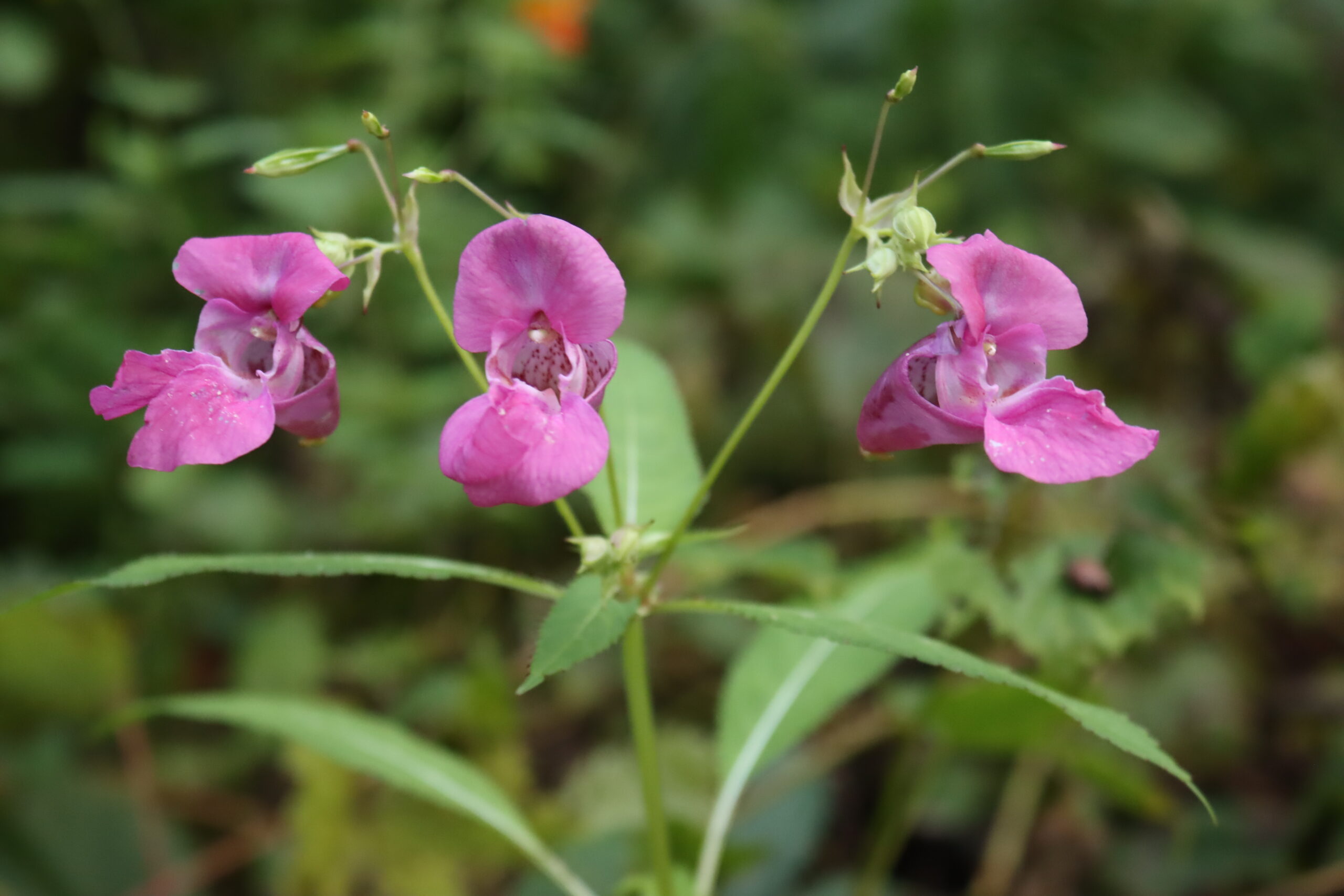
Himalayan Balsam Medicinal Benefits
Historically, herbalists have used Himalayan Balsam seeds as a diuretic, and the root’s juices have been used to treat hematuria or blood in the urine. They also used Himalayan Balsam extract to treat anxiety. In folk tradition, practitioners used the plant to treat minor infections, depression, pain, fractures, rheumatism, and fingernail inflammation.
Externally, herbalists have long recognized Himalayan Balsam as a powerful soothing balm for burns, insect bites, and skin irritations. The leaves, flowers, and stems make excellent poultices or salves.
Modern studies have indicated that Himalayan Balsam may indeed be healthy in moderation. A 2016 study from Industrial Crops and Products found that Himalayan Balsam contained significant amounts of antioxidants and displayed antimicrobial activities.
Another study from 2018 found that Himalayan Balsam is high in omega-3 fatty acids. The researchers noted that the plant has antioxidant and cytotoxic abilities and may be a source of antioxidant and chemopreventive agents.
Further, modern research may support the folk use of Himalayan Balsam for anxiety and depression. A 2018 study found that Himalayan Balsam extract showed significant anti-anxiety activity in mice.
Unfortunately, the external use of Himalayan Balsam hasn’t been the focus of many modern studies. Related plants like our native Spotted Jewelweed (Impatiens capensis), have also long been known for their ability to soothe burns, poison ivy, insect bites, and other skin irritations. Hopefully, further studies will focus on these effects.
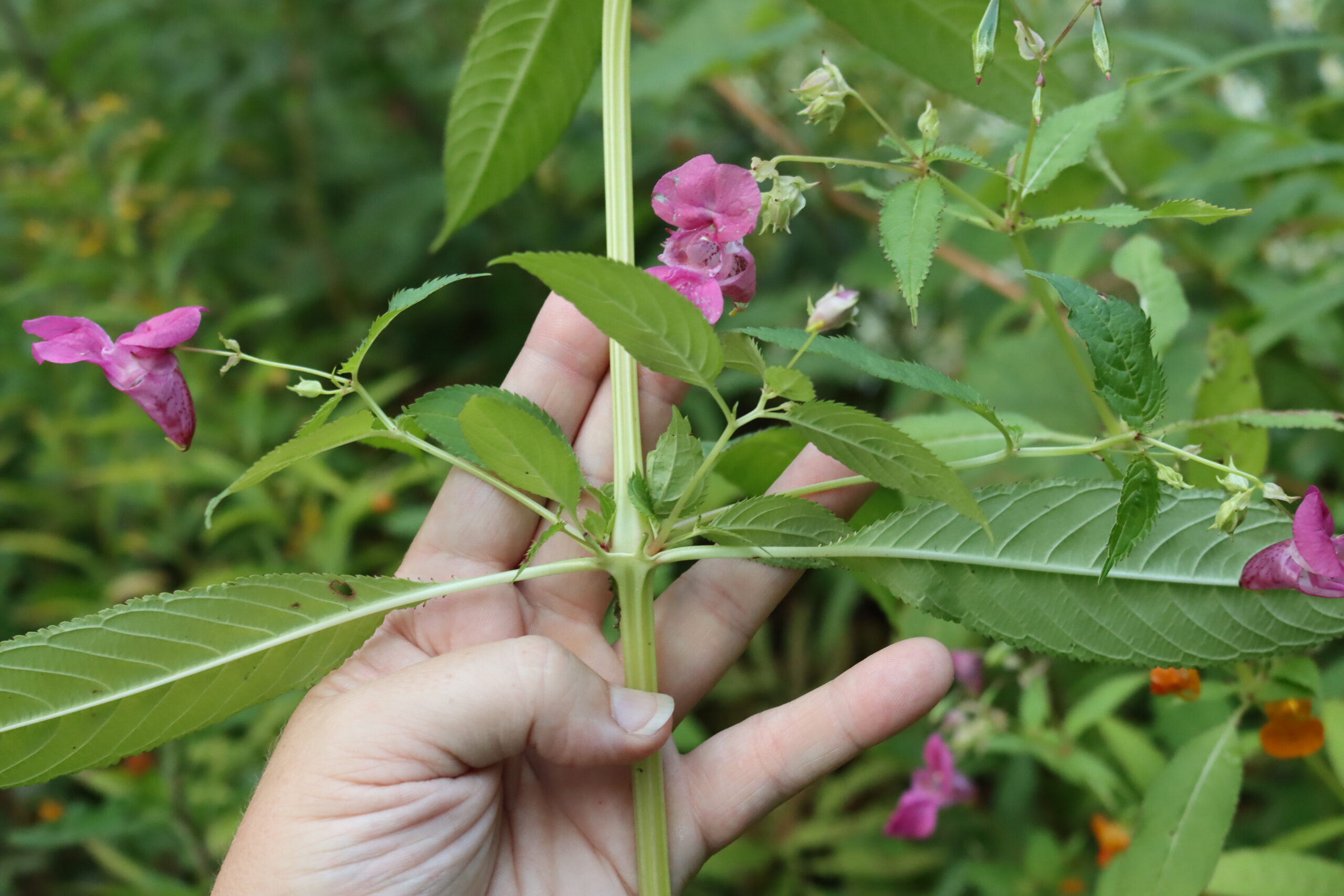
Where to Find Himalayan Balsam
Himalayan Balsam can be found growing wild in its native range in the Himalayan regions of Pakistan, India, and Nepal. However, Himalayan Balsam has spread widely outside its native range. It now grows in Europe, New Zealand, and North America. In North America, it is present in both the eastern and western United States and Canada.
Himalayan Balsam thrives in moist, nutrient-rich soil, particularly in recently disturbed open areas. It will tolerate partial shade. It’s common to find Himalayan Balsam growing in lowland and riparian areas such as ditches, streambanks, forest edges, swamp margins, thickets, and wet waste areas and grasslands. It can also grow in a wide range of soils and at higher elevations.
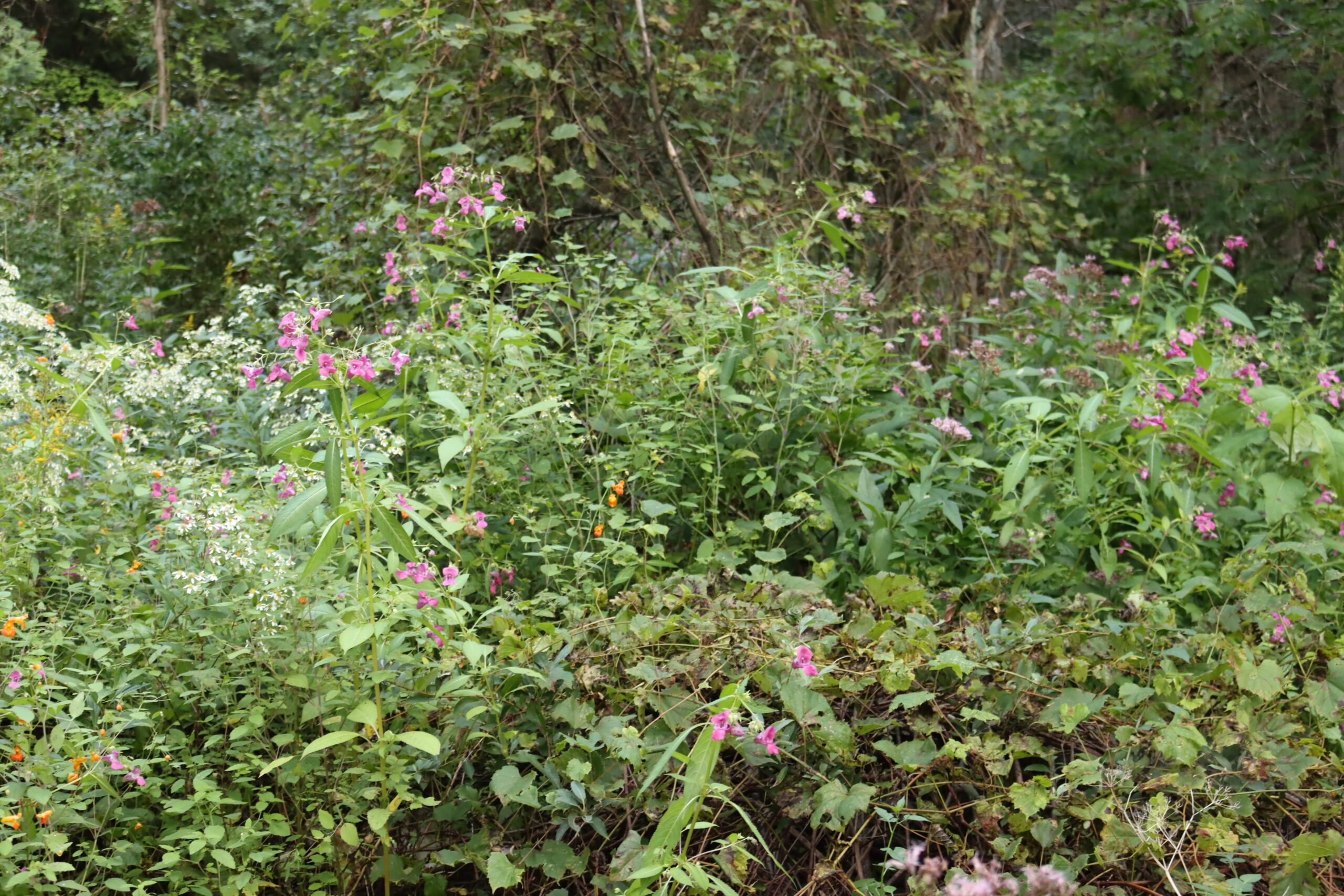
When to Find Himalayan Balsam
Himalayan Balsam is a warm-season annual you’ll only find during the summer. The seeds usually germinate and sprout in April or May, and the plants grow until hard fall frost kills them.
If you’re looking for flowers, Himalayan Balsam has a relatively long bloom period. Depending on your region, you may find it in bloom anywhere from May to October. Plants in southern areas tend to bloom earlier than those in the north.
Identifying Himalayan
Himalayan Balsam is a large, moisture-loving annual plant. Its heavy seed production allows it to quickly form dense colonies, particularly in recently disturbed areas. The reddish or purple tinges on its stems and leaf veins can help you identify it. Its showy helmet-like pink flowers and explosive seed pods provide other good markers for positive identification.
Himalayan Balsam Leaves
Himalayan Balsam features long, simple lanceolate leaves with sharply pointed tips. The leaves occur opposite or in whorls of three.
They have serrated margins and may be 2 to 10 inches long. The leaves are green, but the leaf veins often have red or purple tinges.
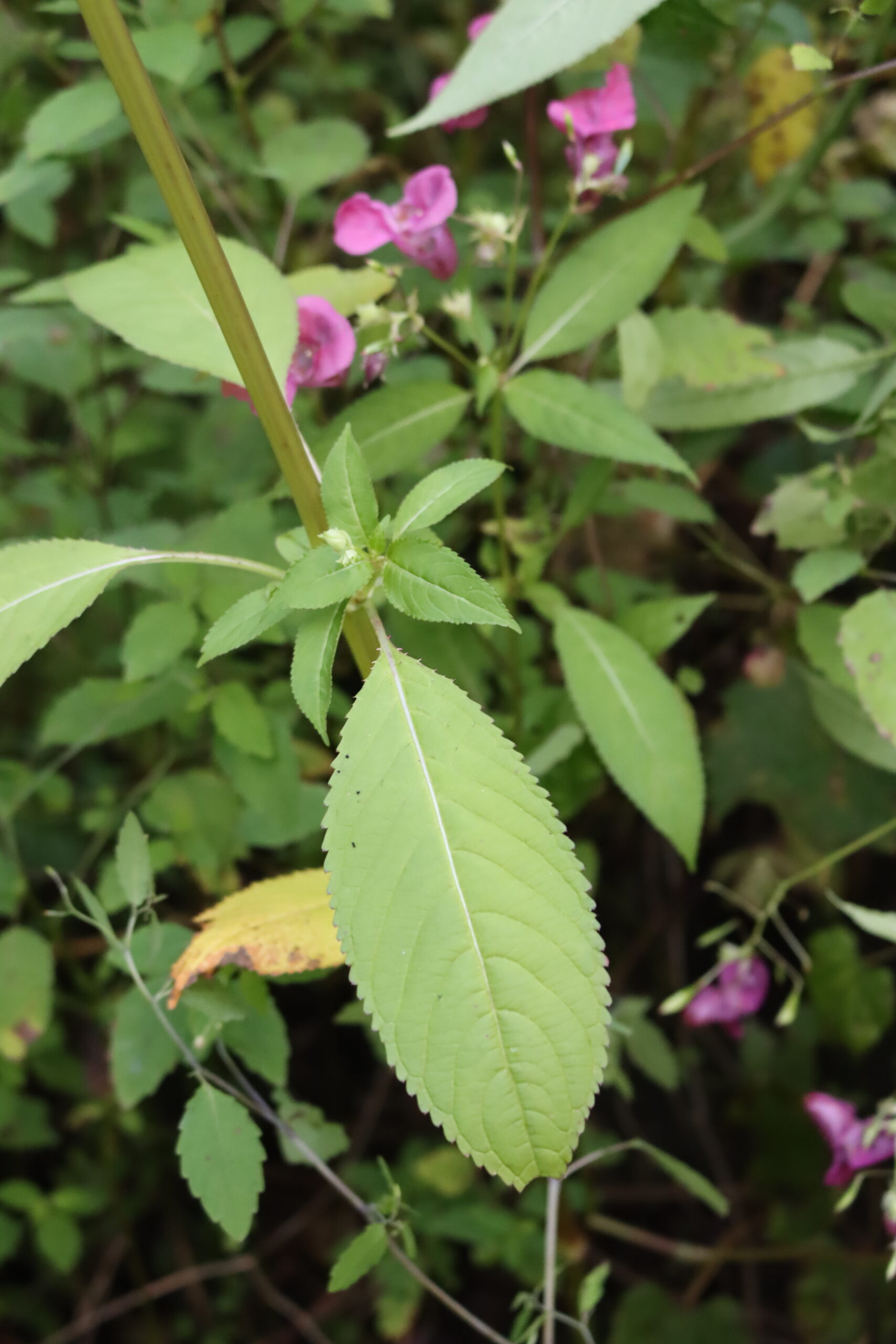
Himalayan Balsam Stems
Himalayan Balsam has large, hexagonal stems that can grow from 3 to 10 feet tall. The stems are usually tinged with red or purple.
They are smooth, hairless, hollow, and easily broken.
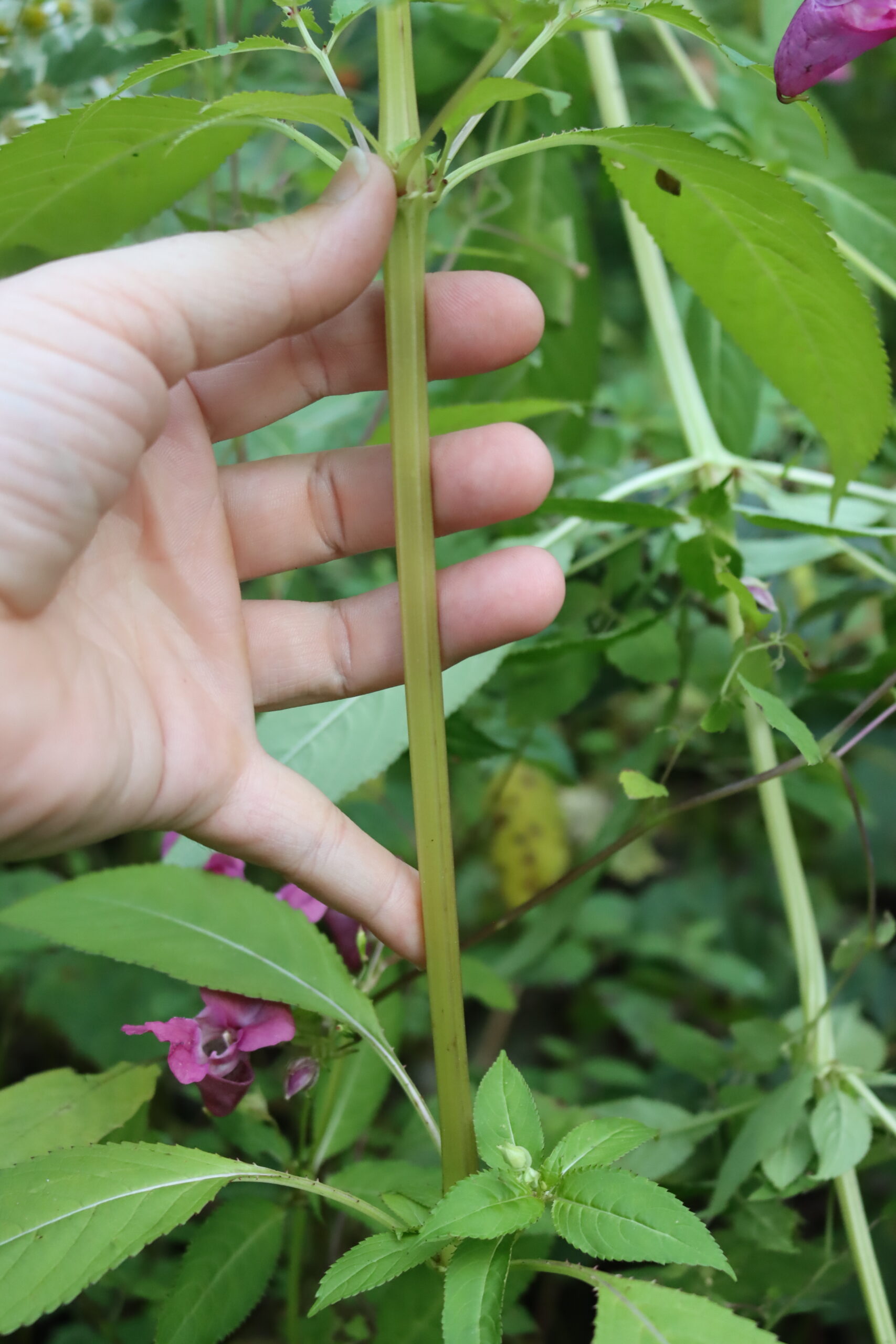
Himalayan Balsam Flowers
Himalayan Balsam puts on showy pink, purple, or occasionally white flowers between May and October. The flowers are helmet- or hood-shaped with bilateral symmetry and are 1 to 2 inches long.
The flowers typically grow in clusters of 5 to 10 flowers per stem.
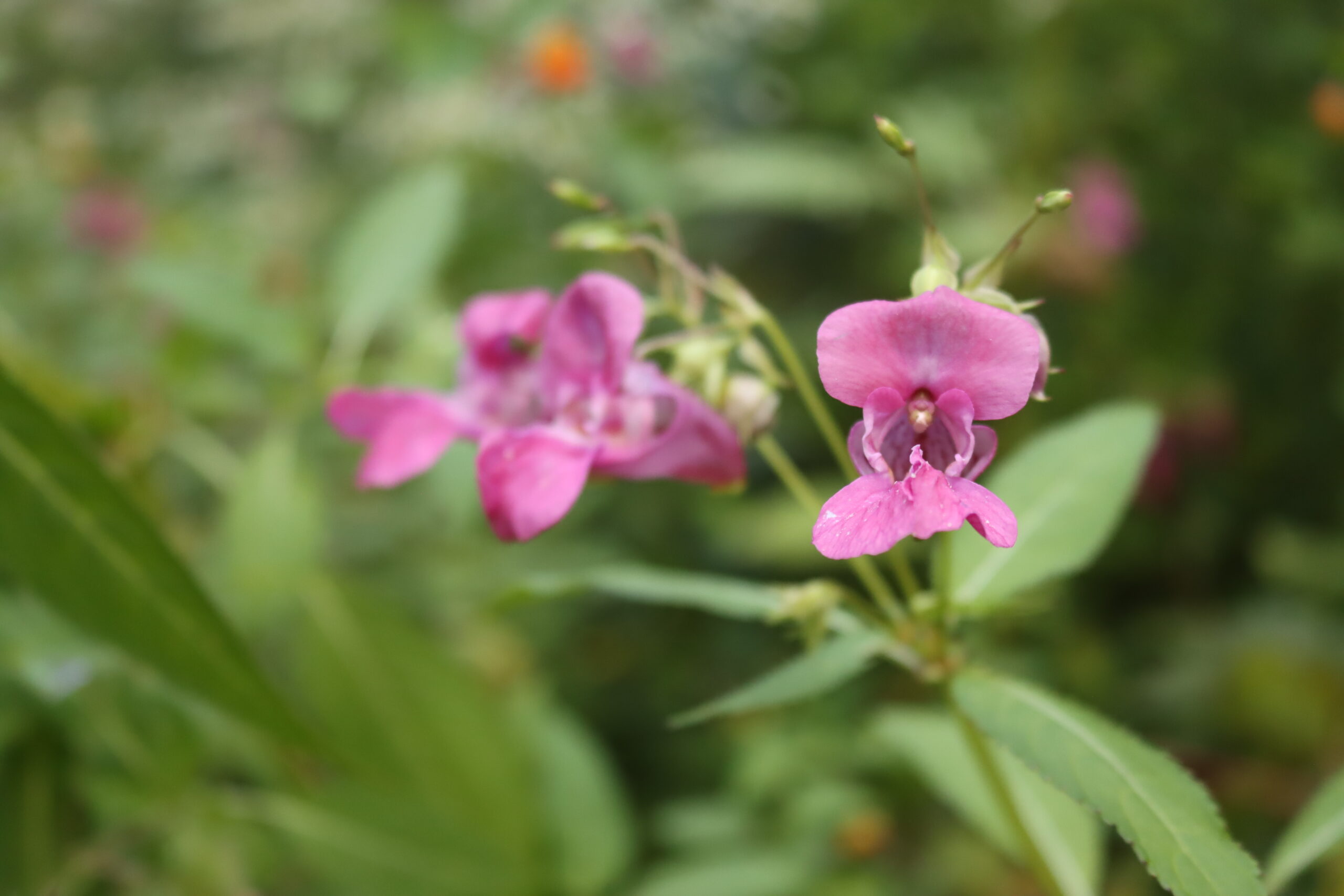
Himalayan Balsam Seeds
After flowering, Himalayan Balsam produces ¾ to 1 ½ inch seed pods that taper at each end. Like other plants that share the Touch-Me-Not moniker, these seed pods explode at a touch when ripe and send their 4 to 16 seeds flying up to 15 feet away.
A single plant may produce 800 seeds.
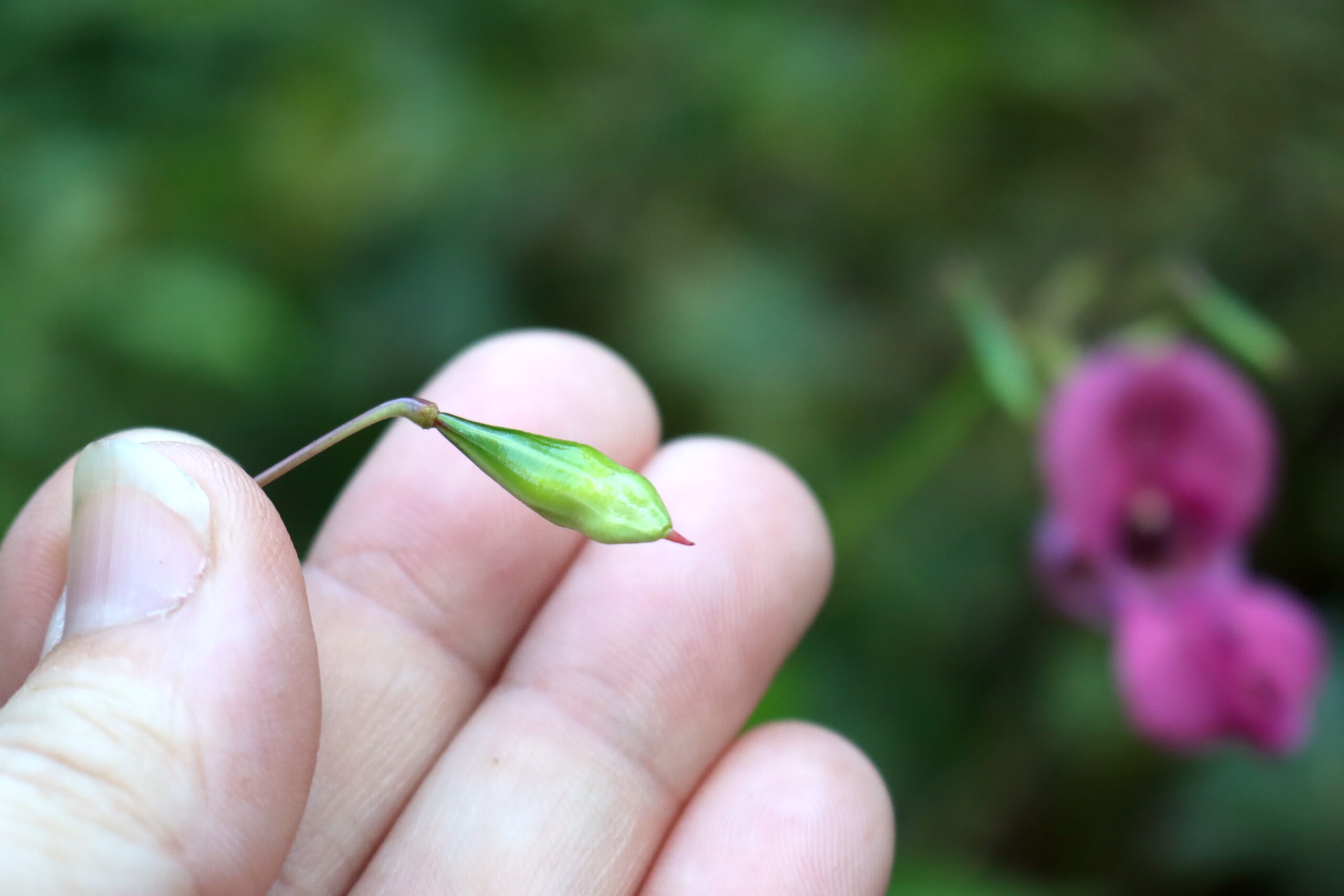
Himalayan Balsam Look-Alikes
Himalayan Balsam may be confused with our native Spotted Jewelweed or Orange Balsam (Impatiens capensis). You can tell them apart in the following ways:
- Spotted Jewelweed typically only reaches 3 to 5 feet tall.
- Spotted Jewelweed has coarsely toothed, ovate leaves that form alternately on the upper stems.
- Spotted Jewelweed leaves usually only reach 5 inches long at most.
- Spotted Jewelweed has orange, rarely red or yellow, flowers.
Himalayan Balsam can also be mistaken for another native jewelweed, pale jewelweed (Impatiens pallida). However, there are a few key ways to tell them apart:
- Pale Jewelweed usually only grows up to 5 feet tall at most.
- Pale Jewelweed leaves are ovate with coarsely toothed margins and up to 4 inches long.
- Pale Jewelweed leaves are alternately arranged.
- Pale Jewelweed has yellow flowers.
Lastly, Himalayan Balsam may be mistaken for another moisture-loving, non-native species, Hairy Willow-herb (Epilobium hirsutum). Here are a few easy-to-spot ways to tell them apart:
- Hairy Willow-Herb’s pink flowers feature radial symmetry.
- Hairy Willow-Herb has very hairy stems and hairy leaves.
- Hairy Willow-Herb leaves are usually 1 to 5 inches long.
- Hairy Willow-herb is a perennial with solid stems.
Ways to Use Himalayan Balsam
You can eat the fresh Himalayan Balsam leaves, young shoots, flowers, and seed pods. The young shoots, leaves, and flowers all make lovely additions to salads or can be used as potherbs in soups and stews.
The stunning pink flowers are also great for decorating cakes and other confections. You can also use them to make syrup, jam, cocktails, or fermented champagne-like beverages.
The seeds have an excellent nutty flavor, both immature and light green and mature and brown. They make great additions to baked goods and are traditionally used in Indian Curries.
Remember that Himalayan Balsam is high in calcium oxalate and should be used in moderation.
One of the best ways to use Himalayan Balsam is externally. When crushed or chewed up, its leaves, flowers, and stems make an excellent, soothing poultice for nettle stings, sunburn, insect bites, and other skin irritations. It’s a great plant to recognize if you’re a hiker!
You can blend it up and freeze it for later use, too. Himalayan Balsam ice cubes are great for sunburn! Alternatively, you can use it in soothing salve, soap, or lotion recipes.
Fiber artists may also enjoy using this invasive plant. Himalayan Balsam may yield lovely yellow, gold, brown, or greenish-tinged dyes for cotton, wool, or other natural materials with different mordants.
Himalayan Balsam Recipes
- If you’re ready to try a simple fermenting project, try this Himalayan Hooch recipe from UK Foraging. This salmon-pink, fizzy, alcoholic drink will impress all your foraging friends!
- This cheerful, pink Himalayan Balsam Syrup from Homestead Herbs and Healing also looks perfect for adding to desserts and mocktails.
- Homestead Herbs and Healing also has some fun-looking recipes for Himalayan Balsam ice cream, jelly, and smoothies!
- Catch the nutty-flavored seeds of Himalayan Balsam for this tasty twist on Curry from EatWeeds.
- Try these Pan-fried Burdock and Balsam balls on a wild salad with a Corsican pine needle dressing from The Other Andy Hamilton for another savory dish.
- Try experimenting with Himalayan Balsam as a natural dye with this post from Wool – Tribulations of Hand Spinning and Herbal Dyeing.
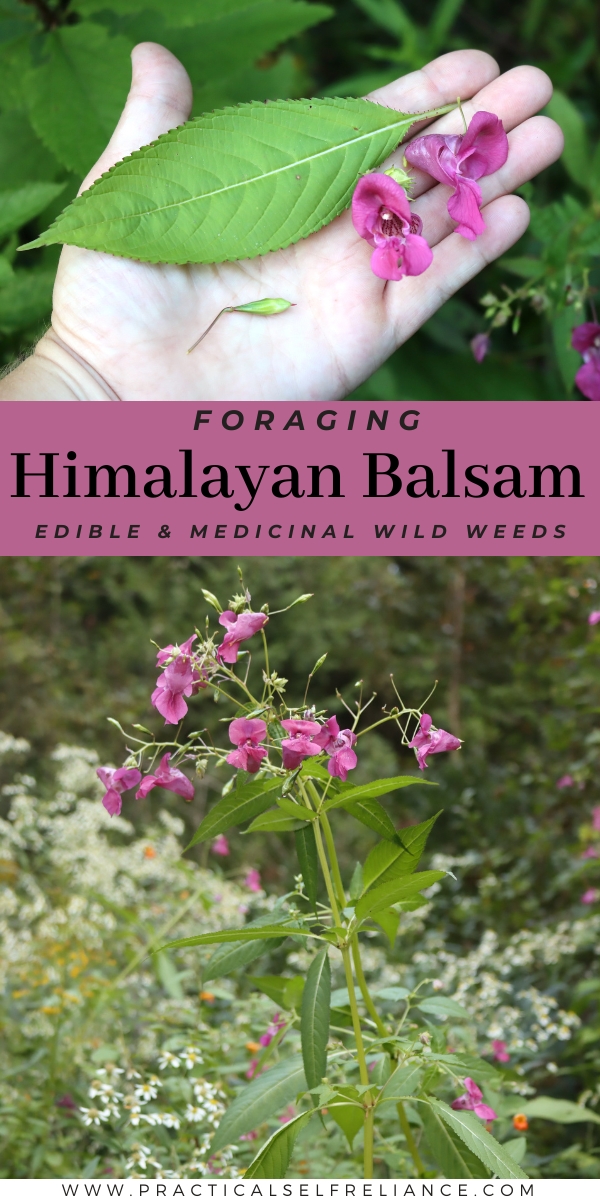

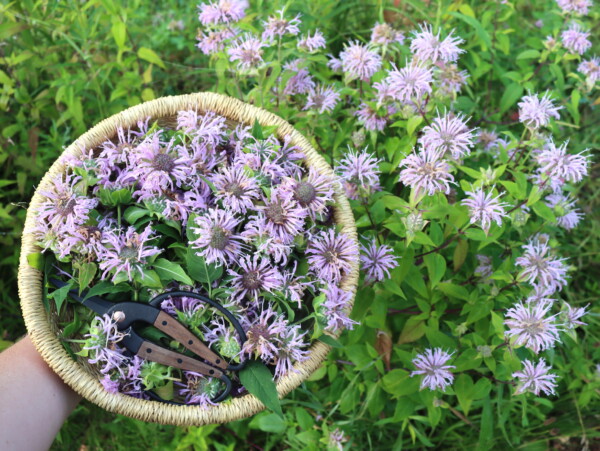
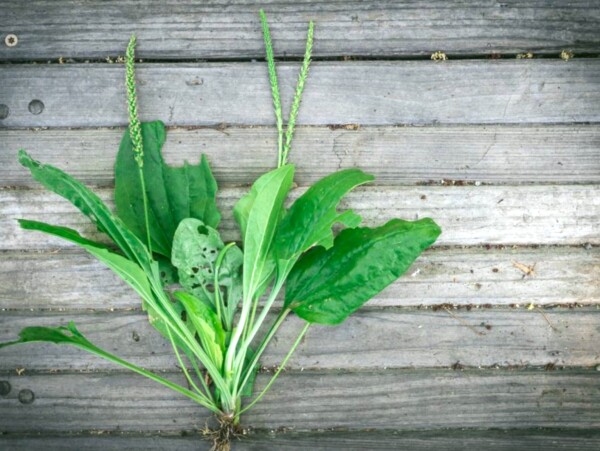
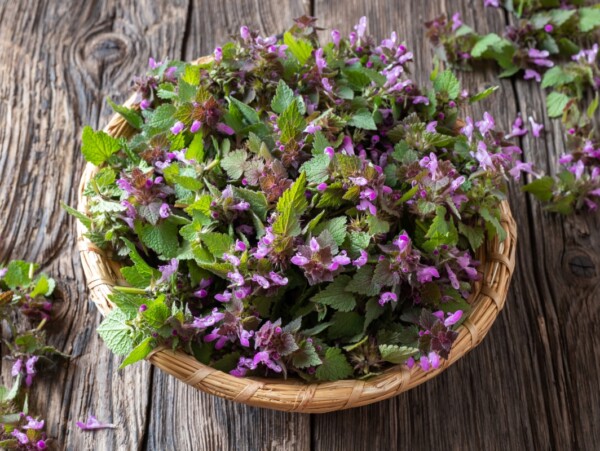










Great article! Absolutely love this plant, although so many people hate it and kill it where I live in Ireland… it’s terrible to see such unfounded hatred.
Thank you for all you do Ashley! You are wonderful!
Keep up the good work and much love to your family ♥
Yan
You’re very welcome. Thank you so much for your kind words.